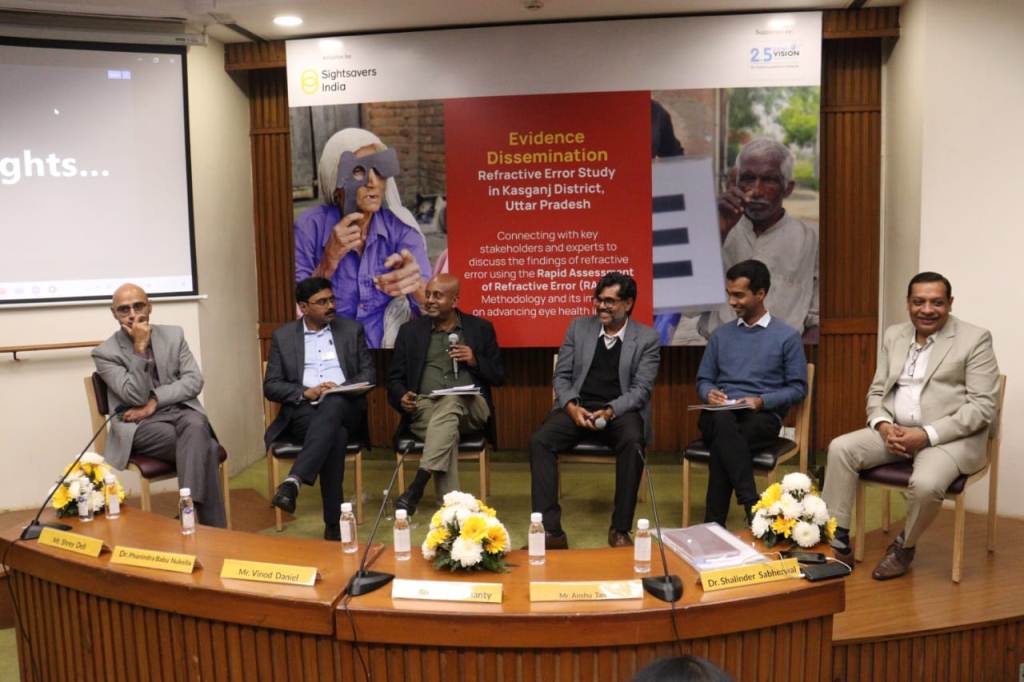New Delhi, India: Sightsavers India, in collaboration with EssilorLuxottica revealed the findings from their Rapid Assessment of Refractive Errors (RARE) study conducted in Kasganj district, Uttar Pradesh. The evidence dissemination event was held at India International Centre, New Delhi, bringing together eminent experts, practitioners, and policymakers to address the challenges and opportunities in combating refractive errors in India.
The event highlighted the significant gaps in refractive error service delivery and equity, presented innovative methodologies used in the study, and proposed actionable recommendations for future policies and programs. The comprehensive study, sponsored by EssilorLuxottica, examined people aged 15-49 years and revealed that uncorrected refractive errors (URE) account for 78% of visual impairment cases in the region, significantly impacting the working-age population’s productivity and quality of life.
The event featured- Mr Narsimhan Narayanan, President of EssilorLuxottica; Mr R. N. Mohanty, CEO of Sightsavers India; Dr. Umang Mathur, CEO, Dr Shroff’s Charity Eye Hospital; Ms Elizabeth Kurian, CEO, Mission for Vision and Member of the WHO Strategic and Technical Advisory Group on SPECS 2030 Initiative; and other eminent experts form EssilorLuxotica, Vision 2020, India Vision Institute, Shroff Eye Hospital, Vision Spring, The Nudge Foundation, Optometry Confederation of India and Kasganj C M C Hospital. The Presentation on the Findings of the RARE Study by Dr Sandeep Buttan and Dr Ananta Basudev Sahu from Sightsavers India shed light on the multifaceted approach needed to address this pressing issue.
Key Findings-
Higher prevalence -People above 40 years of age had a significantly higher prevalence of visual impairment compared to those below 40.”
Gender Inequities- Spectacle coverage was significantly lower among women, with only 9.57% of females over 35 having access to near-vision glasses.
Barriers to Access- Distance from services was a significant obstacle
The event featured a panel discussion on “Refractive Errors: A Public Health Challenge and Pathways to Universal Eye Health,” moderated by Mr. Vinod Daniel, CEO of India Vision Institute. Distinguished panellists included Dr Phanindra Babu Nukella from Vision 2020, and The Nudge Foundation; Anshu Taneja, Managing Director, Vision Spring; Mr Sudipta Mohanty, Area Director, Sightsavers India; Mr Shrey Deb, Associate Director, The Nudge Institute; Dr Shalinder Sabherwal, Director, Public Health and Projects, Dr Shroff’s Charity Eye Hospital.
Mr. Narsimhan Narayanan, President of EssilorLuxottica said “The findings of the RARE report are extremely relevant and align with the size and scale of the problem. Despite advancements across so many fields, a vast population continues to be left behind. While significant efforts are underway, our collective responsibility remains to drive meaningful change. Issues like lack of access, affordability, and deep-rooted societal norms continue to hinder progress in vision care.”
RN Mohanty, CEO of Sightsavers India shared, “As we look back, Rapid Assessment of Avoidable Blindness (RAAB) surveys, which we previously conducted in Kasganj, have largely focused on cataract blindness in the 50+ age group. While this focus has been crucial for planning and monitoring blindness alleviation efforts, it has left us with a significant knowledge gap—particularly when it comes to vision impairment and uncorrected refractive errors in younger populations. The 15-49 age group in this demographic is critical for shaping eye care services that will meet the needs of tomorrow. This is why we embarked on a groundbreaking survey in a rural district in North India.”
“I am confident this report will have a meaningful impact on addressing key areas such as access to refractive error care, building the capacity of personnel, including grassroots workers like ASHAs, and tackling presbyopia,” said Elizabeth Kurian, Chief Executive Officer – Mission for Vision.
“The report is important. Kasganj district in UP is representative of most of the hinterland. Only 30% population has access to spectacles! A simple pair of reading glasses can improve productivity 3x. And, with Myopia on the rise, children’s learning gets affected by uncorrected refractive error.” said Dr Umang Mathur
Dr Sandeep Buttan, Technical Lead Eye Health, Sightsavers India said “During our findings in Kasganj we found that majority of out-of-pocket expenses where the individual was paying for the spectacles. 84% optical shops and 14 % private clinics. This makes access an issue for all.”
Dr Ananta Basudev Sahu, Senior Manager of Programme Performance, Research, and Learning, Sightsavers India, stated that “this first-of-its-kind research in the state assessed the prevalence of refractive errors, spectacle coverage, and barriers to accessing corrective eyewear. Using robust methodology, the study gathered valuable data and actionable insights. The findings are expected to guide policies that improve eye care services, reduce visual impairment, and enhance community well-being.”
The study recommended that interventions aimed at improving spectacle coverage and access, particularly for those with presbyopia, should be considered to enhance eye health and overall quality of life in the community.
The concluding remarks by Mr Prasannakumar N, Senior Director, Programme Operations, Sightsavers India, emphasised the integration of study findings into broader eye health programmes. The event then concluded with a commitment from participating organisations to strengthen collaboration and develop innovative solutions to address the challenges found in the study.
By bringing together diverse voices, the Evidence Dissemination event not only celebrated the success of the RARE study but also paved the way for collaborative efforts to eliminate avoidable blindness and visual impairment in India.
Disclaimer: This media release is auto-generated. The CSR Journal is not responsible for the content.


